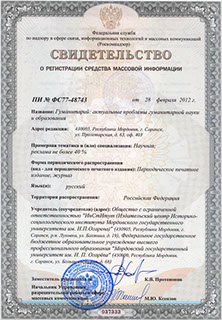ГуманитариЙ актуальные проблемы гуманитарной науки и образования
Russian Journal of the Humanities
ISSN 2078-9823 (Print)
ISSN 2587-7879 (Online)
Navigation
ISSN 2078-9823 (Print), ISSN 2587-7879 (Online)
DOI: 10.15507/2078-9823.051.020.202003.237-248
Ranus R. Sadikov
Kuzeev Institute for Ethnological Studies – Subdivision of Ufa Federal Research Centre of the Russian Academy of Sciences (Ufa, Russia), e-mail: kissapi@mail.ru
Mordva-Murza from Bashkiria: The History of Formation and Ethno-cultural Features of Ethnic-Class Community
Introduction. One of the regions of compact settlement of the Mordovian people is the Republic of Bashkortostan. The Mordovian population of the region was formed during the resettlement migration process of the ethnic groups to the Bashkir lands in the 17th and early 20th centuries. There is a small stand-out group of Mordva-Erzya in Bashkiria. They call themselves Murza and they have their own identity. They live in the village of Kozhay-Andreevo in the Tuimazinskiy district and in the village of Kozhay-Maximovo in the Ermekeevskiy district. Materials and Methods. This work attempts to reconstruct the history of formation of the class community of Mordva-Murza and to identify its ethno-cultural features. The study is based on the principle of historicism; the main methods are historical-genetic, comparative-historical, and problematic-chronological. Results. Based on the study of published sources and literature, it is shown the chronology and the main stages of the formation of the Mordva-Murza community in Bashkiria. It was revealed, this community was formed on the basis of a resettlement group of the Mordovian sluzhilye-served people in the 18th century. Field ethnographic materials testify to their ethno-cultural identity. Discussion and Conclusion. Mordva living in the villages under consideration can be defined as a separate ethnic-class community, which has its own identity, self-name, specific linguistic and ethno-cultural characteristics. In their language and culture, it is interweaved both Erzya and Moksha traits. Almost disintegrated in the 1980s the community of the “Kazhay Murzas” began to revive in the year of 2000. The observations show the desire of the inhabitants and natives from these villages to preserve and develop their “Murza language” and traditions.
Keywords: Mordva, Murza, history of formation, ethnic-class, ethno-cultural features, Bashkiria.
Acknowledgements: The research was carried out as part of a state task АААА-А18-118041290047-7 (Russian Academy of Science).
For citation: Sadikov R. R. Mordva-Murza from Bashkiria: the History of Formation and Ethno-cultural Features of Ethnic-Class Community. Gumanitarian : aktual’nye problemy gumanitarnoi nauki i obrazovaniia = Russian Journal of the Humanities. 2020; 20(3): 237–248 (In Russ.). DOI: 10.15507/2078-9823.051.020.202003.237-248.

© Ogarev Mordovia State University. History and Sociology Institute, 2017
68, Of. 411, Bolshevistskaya St., 430005, The editorial office of the scholarly journal «Russian Journal of the Humanities»
Tel.: (8342) 24-25-90; 27-07-11, Fax: (8342) 24-25-90, E-mail: jurnal-econom-hist@isi.mrsu.ru
Designed by A. Napalkov, Email: napalkov@isi.mrsu.ru

